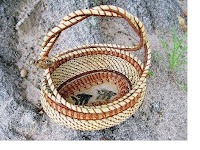 This is something that most people don’t even think about. Right handed people tend to coil in a counterclockwise fashion, that is, to the left…with the bundle of pine needles going to the left, so the left hand can feed the bundle. (As Tony mentioned in his comment the other day.) This is generally faster and easier because one does not have to put down the binder to feed the coil.
This is something that most people don’t even think about. Right handed people tend to coil in a counterclockwise fashion, that is, to the left…with the bundle of pine needles going to the left, so the left hand can feed the bundle. (As Tony mentioned in his comment the other day.) This is generally faster and easier because one does not have to put down the binder to feed the coil. Of course, this means left handed people, using the opposite hand, tend to coil clockwise, to the right. If you have tried both ways, you will find that, for most people, it is easier when the hand doing the most moving around is not near that open bundle of fibers. I said MOST people, Carol. Carol, being a self-taught coiler, is a left handed person, but coils counterclockwise (to the left.) Go figure. It works for her. Again, do what works for you.
Of course, this means left handed people, using the opposite hand, tend to coil clockwise, to the right. If you have tried both ways, you will find that, for most people, it is easier when the hand doing the most moving around is not near that open bundle of fibers. I said MOST people, Carol. Carol, being a self-taught coiler, is a left handed person, but coils counterclockwise (to the left.) Go figure. It works for her. Again, do what works for you. It really behooves you to be able to coil in either direction, because when it comes to sculptural coiling, sometimes to execute a particular form, it is necessary to go in the opposite direction from what you are used to. Case in point, this really amazing sculptural pine needle piece by TV McArthur…maybe we can bring him out of the woodwork, as well. TV used to be very active in the Pine Needle Group, but has drifted away. And I am sorry…he is simply the most imaginative sculptural coiler I have ever seen in my life, and a wonderful correspondent to boot. It would be really great to hear from you again, TV!
It really behooves you to be able to coil in either direction, because when it comes to sculptural coiling, sometimes to execute a particular form, it is necessary to go in the opposite direction from what you are used to. Case in point, this really amazing sculptural pine needle piece by TV McArthur…maybe we can bring him out of the woodwork, as well. TV used to be very active in the Pine Needle Group, but has drifted away. And I am sorry…he is simply the most imaginative sculptural coiler I have ever seen in my life, and a wonderful correspondent to boot. It would be really great to hear from you again, TV!Does it make sense that:
Coiling clockwise and putting your needle in from the front
is the same as
coiling counterclockwise and putting your needles in from the back.
You with me so far? It is just a matter of which side you are looking at the basket from.
Then you need to realize that there are actually two different spirals in every basket.

There is spiral #1, of the core, going round and round,
and
spiral #2 of the binder, going around the core, that which we think of as separate “stitches” (marked by different colors,) but is actually just one long spiral.

(I really needed some diagrams here, and that is what has taken me so long….i hope they make sense!)
So, even though we have named stitches and are describing what we think is the same action, the stitch will look different (sometimes very different,) depending on which direction your core is spiraling and which side of the basket you are entering your needle on.
Each stitch has, 2 “faces” (the front and the back, ) and there are 2 different core directions on which they can applied (from the clockwise side or from the counterclockwise side.) This makes 4 different “looks” for each separate stitch.
If you study geometry, you might talk about Archimedes and the tangent of the spiral. But I am not a mathematician. All I know is that the two spirals in the basket (the core spiral and the stitch spiral) intersect at different places, depending on all the different interactions. When you add in the tension applied by the sewing needle, holding the spiral to a certain point, it gets even more complicated.
So, for now, suffice it to say that it is NOT the same stitch when you choose to put your needle in from the opposite direction that you usually use…though it might be CALLED the same stitch. It is NOT a mirror image, either.
This is PART of the “answer” to the oft-asked question “why can’t I make a stitch that looks the same, front and back?” Because it is a spiral, NOT a circle.
Enough about stitching direction…now that I have completely confused you (or intrigued you?) I will return to my original blog series….
Next post we are going to talk about using binder, back to what I had intended…that is, if I did not chase you all away with this extremely confusing discussion! Once again, I would LOVE to hear what you have to say about coiling direction! Thanks






























 Thanks to those who read my
Thanks to those who read my 




















